

Best Newspaper Pots for Seed Starting : GardenFork.TV. DIY: Newspaper Pots for Seed Starting/Cuttings. Home / RHS Gardening. Potatoes. What are we doing in the garden right now?
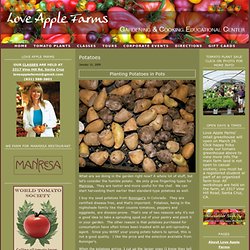
A whole lot of stuff, but let's consider the humble potato. Home & Garden. Sites-Gardeners-Site. Basil is one of the most versatile herbs you can grow.
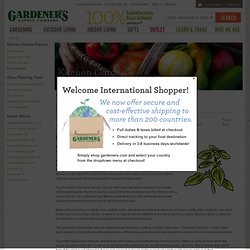
Freshly picked leaves can be added to salads, sandwiches and sauces, and can be made into pesto or dried for use in the winter. Basil has a lower germination rate than many seeds, averaging just 60%. Fortunately, most seed packets contain many more seeds than you’ll need. Basil is a hot weather plant and is very susceptible to frost damage. Seeds and plants should not be put into the ground until the soil is warm (65 to 70 degrees) and the weather has settled. To get a jump on the basil season, you can start your basil seeds indoors, 3 to 4 weeks before planting time. Basil prefers growing in a lightly moist, slightly acidic, well-drained soil that contains lots of organic matter (like compost!). The standard culinary basil, typically used for pesto and Italian cooking, is called ‘Genovese’. Symptoms of bacterial pith necrosis on tomato leaves. Ph-acid-alkaline-food-chart.
Growing Carrots In Plant Containers Makes For Easy Cultivation. I love growing carrots... at least NOW I do!
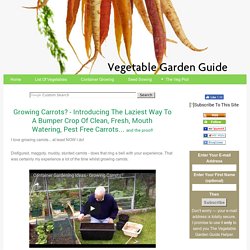
Disfigured, maggoty, muddy, stunted carrots - does that ring a bell with your experience. That was certainly my experience a lot of the time whilst growing carrots. Container Gardening Ideas Video - Planting Carrots in Containers Pots, troughs, growing bags etc. are one of the answers to growing vegetables in your garden if you haven't got the room for a large vegetable plot - like I haven't. Vegetable Garden Growing Tips with Planting Times, Spacing and Guides. How to Start Your Own Square Foot Garden. 5 Secrets to a ‘No-work’ Garden. It took over 20 years of gardening to realize that I didn’t have to work so hard to achieve a fruitful harvest.

As the limitless energy of my youth gradually gave way to the physical realities of mid-life, the slow accretion of experience eventually led to an awareness that less work can result in greater crop yields. Inspired in part by Masanobu Fukuoka’s book, One Straw Revolution, my family experimented with gardening methods which could increase yields with less effort.
Fukuoka spent over three decades perfecting his so-called “do-nothing” technique: commonsense, sustainable practices that all but eliminate the use of pesticides, fertilizer, tillage, and perhaps most significantly, wasteful effort. Here are the strategies we used which enabled us to greatly increase our garden yield, while requiring less time and less work. 1. With ‘no-till’ gardening, weeding is largely eliminated. 2. Gardeners are always on the lookout for free sources of clean organic mulch to add to their garden. List of companion plants. Dill is one of the few plants to grow with Fennel This is a list of companion plants.

Many more are in the list of beneficial weeds. Companion plants assist in the growth of others by attracting beneficial insects, repelling pests, or providing nutrients, shade, or support. They can be part of a biological pest control program. Vegetables[edit] Fruit[edit] Herbs[edit] Flowers[edit] Other[edit] Keyhole Gardens. Keyhole Gardens First made popular in Africa, keyhole gardens are catching on in Texas and other hot, dry places.
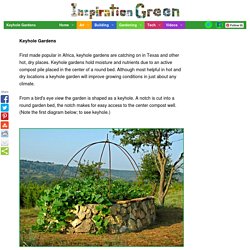
Keyhole gardens hold moisture and nutrients due to an active compost pile placed in the center of a round bed. Although most helpful in hot and dry locations a keyhole garden will improve growing conditions in just about any climate. From a bird's eye view the garden is shaped as a keyhole. A notch is cut into a round garden bed, the notch makes for easy access to the center compost well. Keyhole Garden in Central Texas, Deb Tolman uses keyhole gardens as the main source of her own food supply, and is working on ways to keep them producing throughout multiple seasons and conditions. 2014 Best Spring Planting Dates for Seeds for Dublin, NH. 17 Apart: Growing Celery Indoors: Never Buy Celery Again. Remember when we tested and shared how to grow onions indefinitely last week?
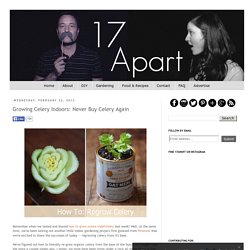
Well, at the same time, we've been testing out another little indoor gardening project first gleaned from Pinterest that we're excited to share the successes of today — regrowing celery from it's base. We've figured out how to literally re-grow organic celery from the base of the bunch we bought from the store a couple weeks ago. Onions. Onions need a sunny, sheltered site in well-drained soil.
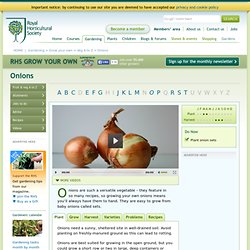
Avoid planting on freshly-manured ground as this can lead to rotting. Onions are best suited for growing in the open ground, but you could grow a short row or two in large, deep containers or raised beds. They are not suitable for growbags. Plant onion sets 10cm (4in) apart in rows 30cm (12in) apart from mid-March to mid-April. Gently push the sets into soft, well-worked soil so that the tip is just showing, and firm the soil around them. If growing from seed, sow 13mm (1/2in) deep in rows 20cm (8in) apart from late February through to early April. Birds can be a problem lifting the sets, so carefully remove the loose skin at the top of the set before planting. Water if the weather is dry and give an occasional feed with a general liquid fertiliser. Mulching the soil will help conserve soil moisture and keep down weeds.